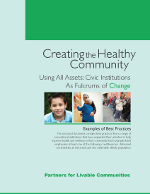
Partners compiled a collection of best practices of traditional community institutions incorporating health and wellness into their agenda and programming to improve community health. The best practices focus on improving the health of at least one of three constituencies: distressed communities, at-risk youth, and the vulnerable elderly.
Examples of institutions include arts and culture organizations, botanical gardens, community development corporations (CDCs), faith-based organizations, libraries, museums, public markets, and zoos.
Click here to download Creating the Healthy Community - Using All Assets: Institutions as Fulcrums of Change
Read more »
Terms:Aging, Community Building, Community Development, Community Engagement, Creating The Healthy Community, Cultural Institutions, Health & Wellness, Healthy Communities, Institutions as Fulcrums of Change , Intergenerational, Libraries, Program Areas, Public Health
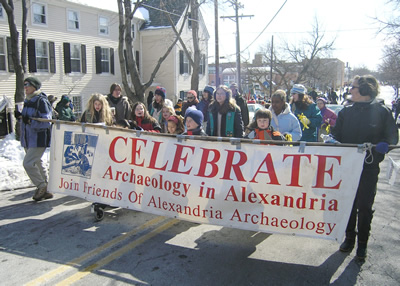
During the 1960s, Washington, DC and its surrounding communities experienced an urban renewal that saw a rebuilding of infrastructure and consequently required the destruction of a number of older buildings in the area. In Alexandria, an independent city a short distance from DC, the destruction of the old buildings uncovered an abundance of historical artifacts that shed light on the history of the area. Realizing that there was a plethora of previously undiscovered, culturally-important artifacts right beneath their feet, the city’s leadership created the Office of Historic Alexandria to try to cultivate and make sense of this new information.
Read more »
Terms:Community Building, Community Engagement, Creative Economy, Cultural Institutions, Heritage, Historic Preservation, IFC Best Practice, Museums, Public-Private Partnerships, Tourism, Washington, DC
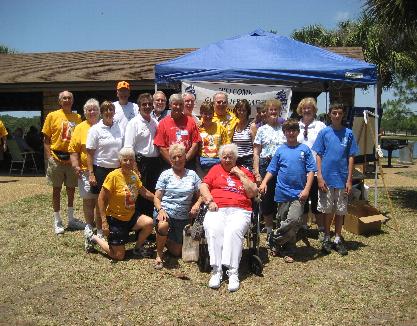
Across America state and local governments are figuring out how to deal with aging populations as modern medicine and technology are starting to ensure that people, on average, live longer. According to the 2012 U.S. Census, Florida possesses one of the oldest populations in the United States, as more than 18% of Florida residents are over the age of 65, almost 5 percentage points higher than the national average. To help their aging population remain healthy and lead productive lives, local governments and community organizations are finding creative ways to encourage active lifestyles for older adults. The Good Life Games of Pinellas County Florida has proven to be a very successful way to encourage fitness among older residents of the county, and their model is being replicated throughout the country.
Read more »
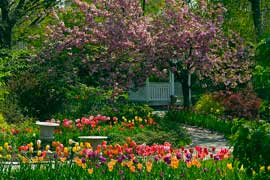
New York City is widely considered to be one of the most diverse places on the planet, with residents from hundreds of different countries living within close proximity of each other. Queens in particular has a broad mix of ethnic populations, which have lead some to consider it the most culturally diverse area in the world. Yet, when Susan Lacerte became the Executive Director of the Queens Botanical Garden, she noticed that the diversity of the borough was not reflected in the Botanical Garden’s attendance. To challenge that, Lacerte started The Ambassador Program to reach out to ethnic communities and find out what they wanted in their public garden.
Read more »
Terms:Arts & Culture, Community Building, Community Engagement, Cultural Institutions, Diversity, Healthy Communities, Heritage, IFC Best Practice, Multicultural, New York City, NY, Parks, Playgrounds & Gardens, Urban

When kids from Commerce, a small working-class city outside of Los Angeles, are asked who their heroes are, they will, more often than not, mention local residents Brenda Villa and Patty Cardenas. Villa and Cardenas were both key members of the Women’s Olympic Water Polo Team from the 2008 Olympic Games in Beijing, China, and they are both products of the Commerce Water Polo Club.
Read more »
As the baby-boomer population all reach the age of retirement, many older individuals are going to be forced into assisted living facilities. This article featured on PlaceMakers by Ben Brown highlights the ElderSpirit Community in Abingdon, VA, which on a relatively small budget, has created a community for older individuals that emphasizes people, skills, and needs.
"Among the Big Issues awaiting communities after we shake off the post-recession blues is what to do about demography. Particularly the part about America’s aging population.
The first-borns among the 76-million-strong Baby Boomer generation reached 65 in 2011. And over the next three decades, the geezer slice of the population pie will swell to 20 percent, compared to a little more than 13 percent in 2010. Take a look at the chart below, compiled from Census projections and pulled from the informative Alliance for Aging site.
That’s more than 88 million folks 65-plus, with the fastest growing cohorts the “oldest-old” segments of 80-plus.
I have a special interest in this topic, given that I’m among those leading-edge Boomers who have reconfigured commerce and culture to suit our tastes over the last half-century. It’s been a great run.
By now, just about everybody not invited to our long-running generational fiesta is tired of indulging Boomer fantasies. Sorry. Since we’re still running lots of stuff and still hoarding most of America’s financial assets, there’s more to come. Currently, we’re in the middle of one of our periodic – and probably our last – reality denial exercises. This is the one where we’re pretending Big Pharma, robots, electric cars and Dr. Oz will extend our playtime into infinity. You know, “60 is the new 40.” Unlike previous Boomer reality ducks, however, this one is going to be tough to buy or lie our way out of....."
Read More.
Read more »
“I know that we—the American people—have the ability: to lead the world; to meet today’s energy challenges; to cross the bridge to a cleaner, more secure world; and most importantly, to leave our grandchildren with a place where they can thrive.” – Jim Rogers at the 2012 Democratic National Convention
After welcoming and thanking all those who helped make the 2012 Democratic National Convention possible in Charlotte, North Carolina, Jim Rogers, co-chair of the Charlotte Host Committee at the Convention, began his address by proclaiming that he was not there as a, “Democrat, Republican, policy pundit, or CEO,” but rather, he was there as a concerned grandfather. Rogers continued with his speech by calling for a more broad based long-term effort toward a future of affordable, reliable, and cleaner energy. He went on to state that, “energy is more than a partisan issue. It’s an American issue. And a global issue.”
Jim Rogers’s commitment to identifying and implementing better practices for cleaner and more efficient energy sources has made him a leading figure in not only the energy industry, but the entire environmental movement. As chairman, president, and CEO of Duke Energy, one of the nation’s leading energy providers, Rogers’s prestigious career in the world of energy and politics began after being hired as an Assistant Attorney General for the Commonwealth of Kentucky, where he advocated for the state’s consumers in gas, electric, and telephone rate cases. He was then appointed to Deputy General Counsel for litigation and enforcement for the Federal Energy Regulatory Commission (FERC), and Executive Vice President of interstate pipeline for the Enron Gas Pipeline Group. After joining PSI Energy as the company’s chairman, president, and CEO in 1988, he served as chairman and CEO of Cinergy for more than 11 years before its merger with Duke Energy.
In addition, Rogers has been recognized as one of the most outspoken and respected figures worldwide in the energy industry. In 2011, Rogers was awarded the Asia Society of Washington’s International Business Leadership Award, as well as U.S.-China Policy Foundation’s Global Executive Leadership Award for his work with China to help strengthen the relationship between the two nations, and bring energy to the forefront of global issues. Rogers has testified more than 20 times before U.S. Congressional Committees, has spoken at international forums such as the United Nations General Assembly, the World Economic Forum, the Clinton Global Initiative, and in 2009, Newsweek named him one of “The 50 Most Powerful People in the World.”
Rogers has also done extensive civic work in his current hometown of Charlotte, North Carolina, co-chairing the city’s $82 million campaign to construct a new cultural campus in uptown Charlotte, and by co-chairing Charlotte’s committee to bring the 2012 Democratic National Convention to the city.
Duke Energy has been the largest electric power holding company in the United States for years, supplying energy to approximately 7 million U.S. customers, and was recently named to the Dow Jones Sustainability Index for North America for the seventh consecutive year. With Jim Rogers leading the way, not only does Duke Energy have a bright future ahead of them, but the rest of the world, and especially his grandchildren do as well.
Read more »
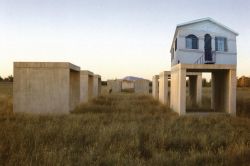 Photo Credit: Alan Rosenblum Photo Credit: Alan Rosenblum
Courtesy of Estudio Teddy Cruz
Home to the nation’s busiest United States-Mexico border crossing, San Ysidro is a suburb of San Diego, California, that lies just north of Tijuana, Mexico. Comprising mostly third- to first- generation immigrants, San Ysidro is often ignored, viewed as a place to pass through on the way to and from the border. Many San Ysidro-Tijuana families live in a bi-national condition, a state of being that finds families, work, education, affordable housing, health care, and economies tied to one another, and one that is currently struggling with the hot spots of drug cartel violence. Casa Familiar, a San Ysidro-based nonprofit organization, is working to invigorate the community by advocating for and assisting the residents in such areas as immigration services, education, and job placement[i].
Lyz Crane draws on the work of practitioners and researchers to characterize the field of arts-based community development in which arts and culture can help achieve place based change related to the physical, social, and economic dimensions of place. This paper examines the premise that the existence of arts is considered a powerful end in itself, Crane then outlines the variety of ways that the actors and activities involved in arts and community development work can relate to and interact with each other to create sustainable communities. Looking at the cultural ecology of place, creative economy development focuses on fostering local creative businesses and supporting creative workers both in the arts and in supporting industries while cultural development may focus on preserving cultural assets—traditions, language, stories—or on building on them to create stronger, more connected communities. There is also a complex community development ecosystem of organizations, interests, and tools. Stakeholders may involve arts in their agendas, create arts programming, provide or develop arts spaces, employ artists, and/or partner with arts organizations. Indeed, both the arts and community development are part of the same ecosystem and all of these 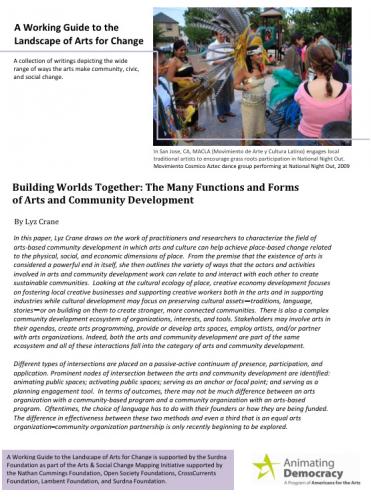 interactions fall into the category of arts and community development. interactions fall into the category of arts and community development.
Crane places different types of intersections on a passive-active continuum of presence, participation, and application. Prominent nodes of intersection between the arts and community development are identified: animating public spaces; activating public spaces; serving as an anchor or focal point; and serving as a planning engagement tool. Crane points out that, in terms of outcomes, there may not be much difference between an arts organization with a community-based program and a community organization with an arts-based program. Oftentimes, the choice of language has to do with their founders or how they are being funded. The difference in effectiveness between these two methods and even a third that is an equal arts organization–community organization partnership is only recently beginning to be explored.
Click here to download the whole document.
Read more »
Terms:2012, Arts & Culture, Business, CBC Report/Publication, Community Building, Community Development, Community Engagement, Creative Economy, Cultural Institutions, Featured, Other Reports/Publications, Placemaking, Public Art, Public-Private Partnerships
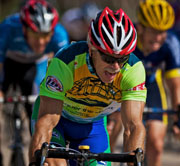 photo credit National Senior Games AssociationThe Good Life Games of Pinellas County encourage adults 50 and over to participate in their own “Senior Olympics,” to promote athleticism and healthy lifestyles. Many older adults are intimidated by the idea of athletic competition, out of fear that an injury or lameness could permanently limit their mobility. Specifically designed to meet the physical capabilities of older adults, the Olympic-style games include archery, track and field, swimming, cycling, and others. Players in Good Life Games are also eligible for statewide and national competitions. photo credit National Senior Games AssociationThe Good Life Games of Pinellas County encourage adults 50 and over to participate in their own “Senior Olympics,” to promote athleticism and healthy lifestyles. Many older adults are intimidated by the idea of athletic competition, out of fear that an injury or lameness could permanently limit their mobility. Specifically designed to meet the physical capabilities of older adults, the Olympic-style games include archery, track and field, swimming, cycling, and others. Players in Good Life Games are also eligible for statewide and national competitions.
Read more »
 photo credit Northwood Park Historical Society photo credit Northwood Park Historical Society
The vision of the Norwood Park Historical Society (NPHS) is to be “recognized as a leader, educator, advocate, and resource” in the community of Norwood Park that “values and preserves its historic character and is acknowledged as an area of historical importance to the city of Chicago and the region.” To reach out to older adults, the NPHS launched Voices of Norwood Park, a personal-history project designed to educate older adults about methods for recording their histories and for collecting written and oral histories of their lives and times in Norwood Park.
Norwood Park is one of the oldest, most distinctive, and historically important neighborhoods in the Chicago metropolitan area. NPHS was formed in 1973 to preserve Norwood Park’s history and promote community awareness. The Society has transformed the oldest house in Chicago, which serves as its offices, into a multipurpose community center with a museum and a café. Its museum focuses on Chicago’s far-northwest side and has a growing collection of historical artifacts and research materials.
Read more »
Terms:2012, Aging, Aging in Place, AIP Best Practice, Chicago, IL, City Leaders Institute on Aging in Place, Community Engagement, Cultural Institutions, Heritage, Historic Preservation, Intergenerational
 photo credit Phoenix New Times photo credit Phoenix New Times
The Arizona Science Center has long engaged adult volunteers age 50+ as docents, and in
other conventional volunteer roles, but only recently the Center began to tap volunteers’ science and technology skills to enhance its programs. Jan Stonebraker, the Science Center volunteer coordinator of four years, entered the position as the Center launched a large travelling exhibition titled Body Worlds 3, an exploration of biology and anatomy.
Stonebraker identified knowledgeable volunteers to help staff the exhibition. At around the same time, the Virginia G. Piper Charitable Trust funded a leadership grant program, through the National Council on Aging (NCOA), to engage adult volunteers age 50+ in leadership roles. The Science Center development staff and Stonebraker designed a program that would qualify for a grant. Stonebraker found that many volunteers were retired mechanical and electrical engineers, information technology specialists, and science teachers who wanted to help the Center. It made eminent sense to use their skills to enhance educational programs.
Read more »
Terms:2012, Aging, Aging in Place, AIP Best Practice, Arizona, City Leaders Institute on Aging in Place, Community Engagement, Education, Intergenerational, Jobs, Life-Long Learning, Museums, Public-Private Partnerships
 photo credit Lifetime Arts photo credit Lifetime Arts
Founded in 2008, Lifetime Arts promotes arts programming designed to engage older adults. A nonprofit organization, Lifetime Arts is committed to developing innovative programs which support creative aging and lifelong learning. To that end, Lifetime Arts offers a variety of services and programs. The organization is a clearinghouse for best practices; provides technical assistance, information services, and professional development to the individuals and organizations serving older adults through the arts; and helps to develop policy to enhance the quality of arts programs for older adults throughout the country.
As a service organization, Lifetime Arts developed Creative Aging in Our Communities: The Public Libraries Project, a program which demonstrates the viability and value of instructional arts programs offered in public libraries as a way to build a broad base of support for creative aging programming. The Public Libraries Project showcases the library as a center for access and learning for older adults; an “age-neutral” public space, the library is an accessible hub for older adults who are reluctant to go to senior centers, and is swiftly becoming an ideal center for programs that interest seniors.
Read more »
Terms:2012, Aging, AIP Best Practice, Arts & Culture, City Leaders Institute on Aging in Place, Community Engagement, Cultural Institutions, Culture Builds Communities, Life-Long Learning, New York City, NY, Rural
 photo credit Massachusetts Cultural Council photo credit Massachusetts Cultural Council
The Elder Arts Initiative joined artists, government, and service providers to engage older adults in the artistic process. Participants in the Elder Arts Initiative learned interviewing skills and techniques employed in the creative process, and had the opportunity to take part in a mentorship or pilot project of their own. Though considerable funding was curtailed in 2002, the Massachusetts Cultural Council (MCC) continues to support local arts programs in the state through grants.
The Initiative began in 1996, when the Cultural Council, the Massachusetts Extended Care Federation (an association of nursing homes), the Executive Office for Elder Affairs, and the State's Council on Aging held a series of meetings about older adults and the arts. The Cultural Council then launched the Initiative in 1997.
The National Endowment for the Arts provided funding for the Initiative through its Challenge America Program Initiative and "Artists and Communities: America Creates for the Millennium Program." For older adults, the benefits of the Initiative included social interaction, an enhanced sense of purpose, a window for introspection, and improvement in physical health. In addition, the Initiative enabled older adults to communicate their wisdom and experience to younger generations.
Read more »
 photo credit Intergeneration Orchestra of Omaha photo credit Intergeneration Orchestra of Omaha
Symbolized by a rose in full bloom and a rose bud, the Intergeneration Orchestra of Omaha (IGO Omaha) joins older, experienced musicians with young musicians, using a love of music to bridge generation gaps. The Orchestra explains that, “The rose in full bloom signifies the lifetime of experience the older musicians bring to the group, while the rosebud represents the emerging talents of our younger artists.” This intergenerational program is a win-win for all involved; the young gain the opportunity to develop their skills, while older participants are able to play the music they love well past the age of retirement. Perhaps more significantly, both young and old find support and friendship as they pursue musical excellence.
With the goal of joining two distinct generations “through the universal language of music,” the IGO of Omaha was started by Chris Gillette, current project director of the Orchestra and the director of the Community Services Division of the Eastern Nebraska Office on Aging (ENOA), and former co-worker Cora Lee Bell. The Orchestra was initially funded by a grant from the Peter Kiewit Foundation, but has since been supported by numerous other grants, donations, memberships, fundraisers, and performance fees, and a sponsorship from ENOA. The Orchestra is run by an elected board of directors, which includes two younger and two older musicians.
Read more »
Terms:2012, Aging, Aging in Place, AIP Best Practice, Arts & Culture, City Leaders Institute on Aging in Place, Community Engagement, Cultural Institutions, Intergenerational, Life-Long Learning, Youth
Housed in a stunning building designed by Frank Lloyd Wright, ASU Gammage at Arizona State University, one of the largest university-based theaters in the world, has been broadening its audience for many years. Its outreach extends to both immigrant and older adult audiences. Widely recognized for its work in Phoenix, ASU Gammage’s commitment becomes evident in the role played by one of its staff members: Michael Reed, the senior director of Cultural Participation and Programming, is responsible for developing and overseeing an astonishing array of performances, including explorations of theater arts for all ages, and programs highlighting the arts of various cultures.
The commitment to accommodating older adults, for example, was demonstrated while The Phantom of the Opera was at the theater for a four-week run. To better suit the preferences of older adult audiences, some performances were scheduled as matinees. Reed also explains that the house staff is very experienced in working with older adults and those who are frail or have disabilities. The staff works with ARTability, an Arizona organization that promotes accessibility to the arts for those with disabilities. Before each season begins, the staff reviews issues related to the Americans with Disabilities Act (ADA), though Frank Lloyd Wright’s design, while handsome, has made retrofitting ASU Gammage to meet the requirements of the ADA, and other evolving audience needs, quite difficult.
Read more »
Terms:2012, Aging, Aging in Place, AIP Best Practice, Arizona, Arts & Culture, City Leaders Institute on Aging in Place, Community Engagement, Cultural Institutions, Diversity, Education, Immigration, Intergenerational, Mobility, Youth
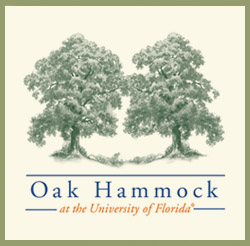 photo credit Oak HammockAs the baby boomers reach retirement age, institutions across the United States will have to find creative solutions to accommodate their burgeoning numbers. Despite this growing need, a retirement community on a college campus might not seem to be a great idea. It’s not difficult to imagine late-night police calls from seniors who think midnight is entirely too late to be playing loud music, or are appalled by the undergraduates who trample the beloved garden of a 90-year old during their late night escapades. But Oak Hammock at the University of Florida, Inc. has created just such an unlikely pairing, a relationship in which university administration, students, senior residents, and other stakeholders have found a lot to like. photo credit Oak HammockAs the baby boomers reach retirement age, institutions across the United States will have to find creative solutions to accommodate their burgeoning numbers. Despite this growing need, a retirement community on a college campus might not seem to be a great idea. It’s not difficult to imagine late-night police calls from seniors who think midnight is entirely too late to be playing loud music, or are appalled by the undergraduates who trample the beloved garden of a 90-year old during their late night escapades. But Oak Hammock at the University of Florida, Inc. has created just such an unlikely pairing, a relationship in which university administration, students, senior residents, and other stakeholders have found a lot to like.
Read more »
Terms:2012, Aging, Aging in Place, AIP Best Practice, Arts & Culture, City Leaders Institute on Aging in Place, Community Engagement, Environment, Florida, Health & Wellness, Housing, Intergenerational, Life-Long Learning, Town-Gown, Youth
 photo credit Osher Lifelong Learning Institutes photo credit Osher Lifelong Learning Institutes
Now a network of 117 higher education institutions spread across the country, Osher Lifelong Learning Institutes (OLLI) offer college-level courses designed to appeal to the interests and experience of older adults. OLLI programs are adapted to the needs and desires of the communities they serve, but they benefit from OLLI’s National Resource Center, which provides a network for sharing innovations in lifelong learning and also sponsors an annual conference. The institutions comprising OLLI range from top research universities to community colleges, and all provide unique programs.
Duke University’s is one of the most successful Osher Lifelong Learning Institutes in the country. The program began as the Duke Institute for Learning in Retirement, which was founded in 1977 as a joint venture between Duke Continuing Education and the Center for the Study of Aging and Human Development. Duke became one of the Osher Lifelong Learning Institutes in 2004.
Read more »
Terms:2012, Aging, Aging in Place, AIP Best Practice, Arts & Culture, City Leaders Institute on Aging in Place, Community Engagement, Education, Museums, National, Regional Cooperation, Town-Gown, Transportation
 photo credit Project SHINE photo credit Project SHINE
“When I first came to America, I only knew a couple letters. I couldn't communicate with anybody. And I learned about this program and I started (to learn English). I have been here for three years and now I have built a basic vocabulary that I can carry my daily life. It basically helped me to live in America." -Project SHINE participant
In the early 1980s, Nancy Henkin, founder and director of the Intergenerational Center at Temple University, was shocked by the news that loneliness and social isolation led an elderly Asian woman to commit suicide, at a time when it was commonly assumed that older immigrants were part of tight-knit and supportive communities. Henkin realized that older immigrants often struggle with language barriers, changes in customs, and differences in social roles more than their younger counterparts, and began working to establish a program that could support them. Project SHINE was launched in 1985, to reach out and provide aging immigrants with language and cultural resources to help them adapt in their new community.
Read more »
Terms:2012, Aging, Aging in Place, AIP Best Practice, City Leaders Institute on Aging in Place, Community Development, Community Engagement, Education, Faith Community, Families, Health & Wellness, Heritage, Immigration, Intergenerational, Jobs, Life-Long Learning, Multicultural, National, Youth
 Partners for Livable Communities presents a PowerPoint presentation to accompany the 2012 Stories for Change report. This presentation is for community residents, city leaders, arts and cultural institutions, and many more to share the great stories of innovation and creativity featured in the Stories for Change report to begin discussions of reaching out to older adults and immigrants with the community. Partners for Livable Communities presents a PowerPoint presentation to accompany the 2012 Stories for Change report. This presentation is for community residents, city leaders, arts and cultural institutions, and many more to share the great stories of innovation and creativity featured in the Stories for Change report to begin discussions of reaching out to older adults and immigrants with the community.
Read more »
|
|